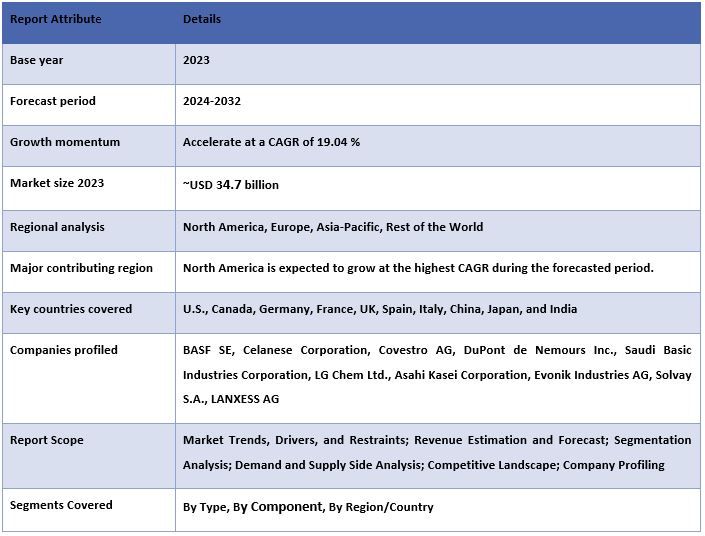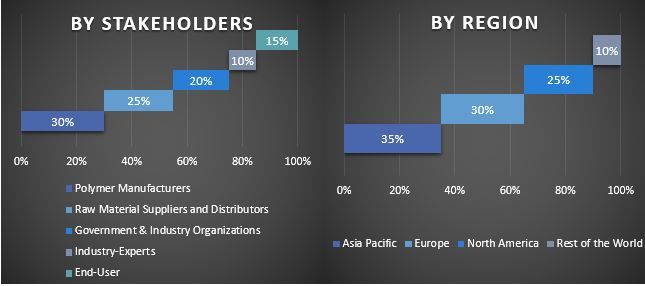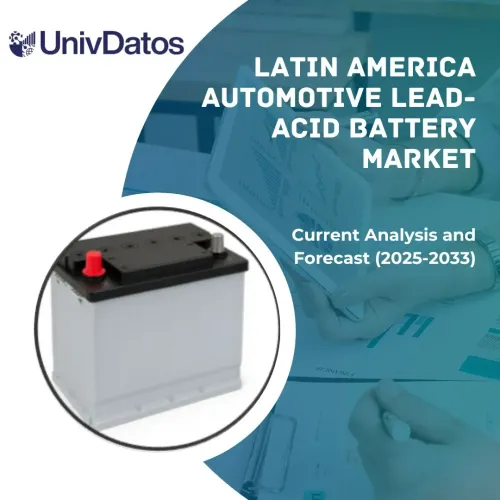- Home
- About Us
- Industry
- Services
- Reading
- Contact Us
Electric Vehicle Polymer Market: Current Analysis and Forecast (2024-2032)
Emphasis on Type (Engineering Plastics and Elastomers); Component (Powertrain System, Exterior, and Interior); and Region/Country
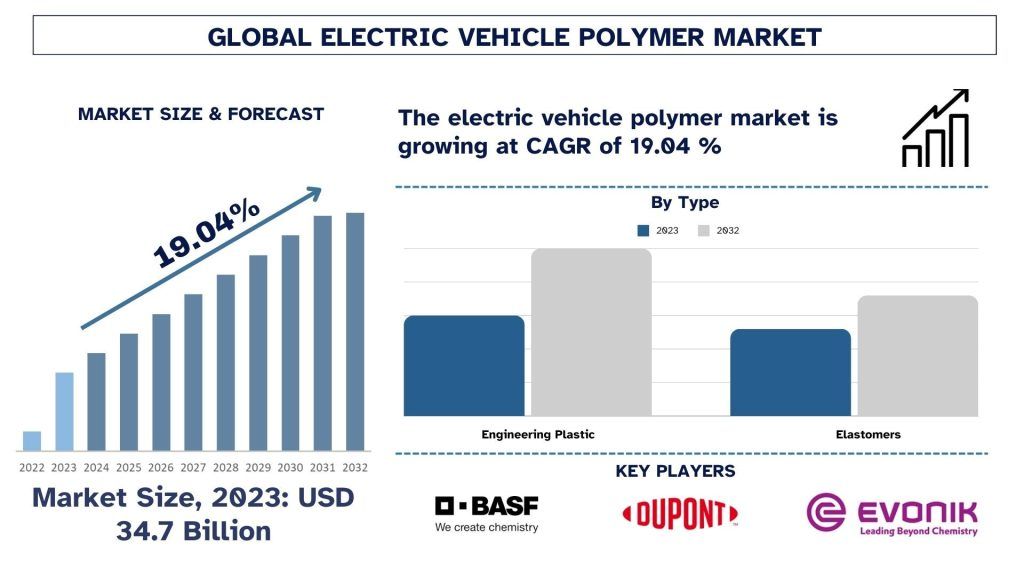
Electric Vehicle Polymer Market Size & Forecast
The Electric Vehicle Polymer market was valued at approximately USD 34.7 Billion in 2023 and is expected to grow at a robust CAGR of around 19.04% during the forecast period (2024-2032) owing to the increasing demand for lightweight, durable materials that enhance vehicle efficiency and range. Additionally, stringent environmental regulations and government incentives for sustainable automotive solutions further propel the market forward.
Electric Vehicle Polymer Market Analysis
Electric Vehicle Polymers are defined as the polymers that are used in electric vehicles to minimize their weight while maintaining vehicle efficiency. In addition, these polymers are the only materials that can replace metals as they share many of their characteristics, including heat resistance, abrasion resistance, stiffness, and toughness. In recent years, the demand for electric vehicle polymers has risen dramatically due to the rising awareness of lightweight vehicles while maintaining their efficiency, performance, and aesthetics. For instance, according to IEA, sales of electric vehicles (EVs) doubled in 2021 from the previous year to a new record of 6.6 million.
Major companies in the market offer EV polymer for the automotive sector with technologically advanced features. For instance, in March 2022, BASF SE had a partnership arrangement with Zhejiang REEF Technology Co., Ltd. to develop cutting-edge recyclate formulations for use in automotive, packaging, and consumer industries.
Electric Vehicle Polymer Market Trends
This section discusses the key market trends influencing the electric vehicle polymer market segments as identified by our research experts.
Engineering plastics type Transforming Industry
Engineering plastics held a dominant share of the market in 2023. This is mainly due to their superior properties, including high strength-to-weight ratios, thermal stability, and resistance to wear and corrosion. It also allows automaking companies to develop cars that are lighter and more energy efficient, which is very important to setting the range and reflexiveness of EVs and even their overall performance as cars. Moreover, engineering plastics’ characteristics, such as high temperature and challenging environment suitability, make them suitable for EVs in critical places. The automotive industry’s change to sustainable production increases the need for recyclable and green engineering plastics even more. Advanced engineering plastics are being unveiled by mergers and acquisitions of rising companies in polymer technology. On January 31, 2020, BASF acquired Solvay’s polyamide (PA 6.6) business. The transaction broadens BASF’s polyamide capabilities with innovative and well-known products such as Technyl. This will allow BASF to support its customers with even better engineering plastics solutions, e.g., for autonomous driving and e-mobility.
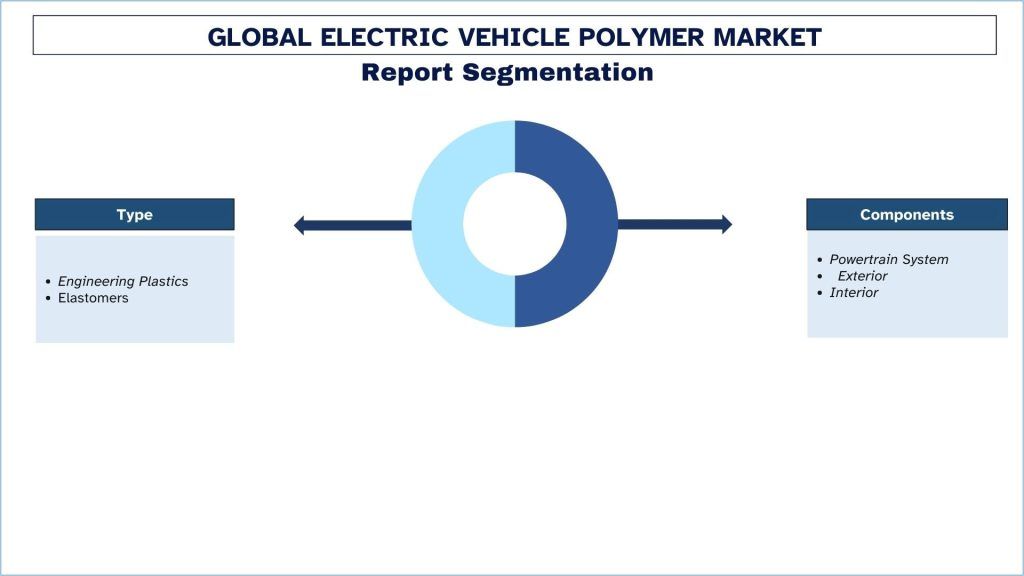
Asia Pacific led the market in 2023
APAC held a significant share of the market in 2023. As the region has become the largest consumer of polymers for electric vehicles (automobiles) due to increased electric vehicle production in developing countries such as China, Japan, South Korea, and others. Additionally, the rising concerns about reducing carbon dioxide emissions, increasing government support, and reducing the overall weight of electric vehicles are the factors boosting the growth of the electric vehicle polymer market in the region. Furthermore, the growing trend of self-driving autonomous and semi-autonomous vehicles creates opportunities for polymers and composite materials in China. Moreover, increasing awareness of greenhouse gas emissions and rising focus on reducing the weight of electric cars are key factors expected to drive revenue growth of the market in this region.
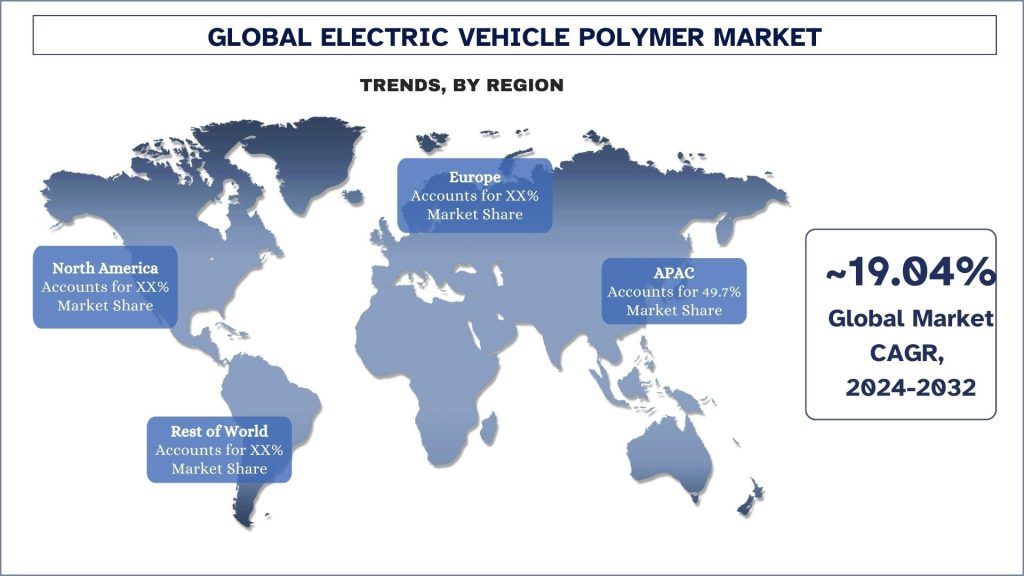
Electric Vehicle Polymer Industry Overview
The electric vehicle polymer market is competitive, with several global and international market players. The key players are adopting different growth strategies to enhance their market presence, such as partnerships, agreements, collaborations, new product launches, geographical expansions, and mergers and acquisitions. Some of the major players operating in the market are BASF SE, Celanese Corporation, Covestro AG, DuPont de Nemours Inc., Saudi Basic Industries Corporation, LG Chem Ltd., Asahi Kasei Corporation, Evonik Industries AG, Solvay S.A., LANXESS AG.
Electric Vehicle Polymer Market News
- For instance, in 2023, Siemens AG, a technology company focused on industry, infrastructure, transport, and healthcare, acquired 8% of Siemens Ltd. India for a purchase price of 2.1 billion euros (approximately USD 2.26 billion). With the help of this acquisition, Siemens and Siemens Energy will jointly propose to the Board of Directors of Siemens Ltd. India to separate the energy business by way of a demerger.
- For instance, in 2023, BASF acquired the site for North American battery materials and recycling expansion in Canada. BASF signed an agreement to secure land for its future cathode active materials and recycling site in Bécancour, Quebec, Canada, as part of its commitment to support North American producers in their transition to e-mobility. A regional supply chain is critical to ensure reliable and resilient battery materials supply.
Electric Vehicle Polymer Market Report Coverage
Reasons to buy this report:
- The study includes market sizing and forecasting analysis validated by authenticated key industry experts.
- The report presents a quick review of overall industry performance at one glance.
- The report covers an in-depth analysis of prominent industry peers with a primary focus on key business financials, product portfolios, expansion strategies, and recent developments.
- Detailed examination of drivers, restraints, key trends, and opportunities prevailing in the industry.
- The study comprehensively covers the market across different segments.
- Deep dive regional level analysis of the industry.
Customization Options:
The global electric vehicle polymer market can further be customized as per the requirement or any other market segment. Besides this, UMI understands that you may have your own business needs; hence, feel free to connect with us to get a report that completely suits your requirements.
Table of Content
Research Methodology for the Electric Vehicle Polymer Market Analysis (2022-2032)
Analyzing the historical market, estimating the current market, and forecasting the future market of the global Electric Vehicle Polymer market were the three major steps undertaken to create and analyze the adoption of Electric Vehicle Polymer in major regions globally. Exhaustive secondary research was conducted to collect the historical market numbers and estimate the current market size. Secondly, numerous findings and assumptions were taken into consideration to validate these insights. Moreover, exhaustive primary interviews were also conducted, with industry experts across the value chain of the global Electric Vehicle Polymer market. Post assumption and validation of market numbers through primary interviews, we employed a top-down/bottom-up approach to forecasting the complete market size. Thereafter, market breakdown and data triangulation methods were adopted to estimate and analyze the market size of segments and sub-segments of the industry. Detailed methodology is explained below:
Analysis of Historical Market Size
Step 1: In-Depth Study of Secondary Sources:
A detailed secondary study was conducted to obtain the historical market size of the Electric Vehicle Polymer market through company internal sources such as annual reports & financial statements, performance presentations, press releases, etc., and external sources including journals, news & articles, government publications, competitor publications, sector reports, third-party database, and other credible publications.
Step 2: Market Segmentation:
After obtaining the historical market size of the electric vehicle polymer market, we conducted a detailed secondary analysis to gather historical market insights and share for different segments & sub-segments for major regions. Major segments are included in the report, such as type, component, and region. Further country-level analyses were conducted to evaluate the overall adoption of testing models in that region.
Step 3: Factor Analysis:
After acquiring the historical market size of different segments and sub-segments, we conducted a detailed factor analysis to estimate the current market size of the Electric Vehicle Polymer market. Further, we conducted factor analysis using dependent and independent variables such as type, component, and regions. A thorough analysis was conducted of demand and supply-side scenarios considering top partnerships, mergers and acquisitions, business expansion, and product launches in the Electric Vehicle Polymer market sector across the globe.
Current Market Size Estimate & Forecast
Current Market Sizing: Based on actionable insights from the above three steps, we arrived at the current market size, key players in the global Electric Vehicle Polymer market, and market shares of the segments. All the required percentage shares split and market breakdowns were determined using the above-mentioned secondary approach and were verified through primary interviews.
Estimation & Forecasting: For market estimation and forecast, weights were assigned to different factors including drivers & trends, restraints, and opportunities available for the stakeholders. After analyzing these factors, relevant forecasting techniques i.e., the top-down/bottom-up approach were applied to arrive at the market forecast for 2032 for different segments and sub-segments across the major markets globally. The research methodology adopted to estimate the market size encompasses:
- The industry’s market size, in terms of revenue (USD) and the adoption rate of the electric vehicle polymer market across the major markets domestically
- All percentage shares, splits, and breakdowns of market segments and sub-segments
- Key players in the global electric vehicle polymer market in terms of products offered. Also, the growth strategies adopted by these players to compete in the fast-growing market
Market Size and Share Validation
Primary Research: In-depth interviews were conducted with the Key Opinion Leaders (KOLs), including Top Level Executives (CXO/VPs, Sales Head, Marketing Head, Operational Head, Regional Head, Country Head, etc.) across major regions. Primary research findings were then summarized, and statistical analysis was performed to prove the stated hypothesis. Inputs from primary research were consolidated with secondary findings, hence turning information into actionable insights.
Split of Primary Participants in Different Regions
Market Engineering
The data triangulation technique was employed to complete the overall market estimation and to arrive at precise statistical numbers for each segment and sub-segment of the global electric vehicle polymer market. Data was split into several segments and sub-segments after studying various parameters and trends in the type, component, and regions of the global Electric Vehicle Polymer market.
The main objective of the Global Electric Vehicle Polymer Market Study
The current & future market trends of the global electric vehicle polymer market were pinpointed in the study. Investors can gain strategic insights to base their discretion for investments on the qualitative and quantitative analysis performed in the study. Current and future market trends determined the overall attractiveness of the market at a regional level, providing a platform for the industrial participant to exploit the untapped market to benefit from a first-mover advantage. Other quantitative goals of the studies include:
- Analyze the current and forecast market size of the Electric Vehicle Polymer market in terms of value (USD). Also, analyze the current and forecast market size of different segments and sub-segments.
- Segments in the study include areas of type, component, and regions.
- Define and analyze the regulatory framework for the Electric Vehicle Polymer
- Analyze the value chain involved with the presence of various intermediaries, along with analyzing customer and competitor behaviors of the industry.
- Analyze the current and forecast market size of the Electric Vehicle Polymer market for the major region.
- Major countries of regions studied in the report include Asia Pacific, Europe, North America, and the Rest of the World
- Company profiles of the Electric Vehicle Polymer market and the growth strategies adopted by the market players to sustain in the fast-growing market.
- Deep dive regional level analysis of the industry
Frequently Asked Questions FAQs
Q1: What is the global electric vehicle polymer market's current size and growth potential?
Q2: What are the driving factors for the growth of the global electric vehicle polymer market?
Q3: Which segment has the largest share of the global electric vehicle polymer market by type?
Q4: What are the emerging technologies and trends in the global electric vehicle polymer market?
Q5: Which region will dominate the global electric vehicle polymer market?
Related Reports
Customers who bought this item also bought

